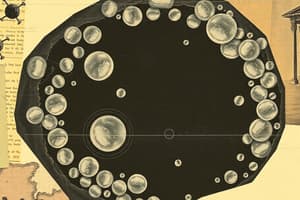Podcast
Questions and Answers
Which of the following is the primary structural component of cell membranes?
Which of the following is the primary structural component of cell membranes?
- A lipid bilayer composed mainly of phospholipids (correct)
- A carbohydrate matrix
- A protein monolayer
- A nucleic acid framework
What property of phospholipids allows them to spontaneously form a bilayer in an aqueous environment?
What property of phospholipids allows them to spontaneously form a bilayer in an aqueous environment?
- They are amphipathic, containing both hydrophilic and hydrophobic regions. (correct)
- They are entirely hydrophilic.
- They are composed of repeating sugar units.
- They are entirely hydrophobic.
How does cholesterol affect membrane fluidity in animal cells?
How does cholesterol affect membrane fluidity in animal cells?
- It increases fluidity at all temperatures.
- It has no effect on membrane fluidity.
- It makes the membrane less fluid at high temperatures and more fluid at low temperatures. (correct)
- It decreases fluidity at all temperatures.
What distinguishes integral membrane proteins from peripheral membrane proteins?
What distinguishes integral membrane proteins from peripheral membrane proteins?
Which of the following factors would decrease membrane fluidity?
Which of the following factors would decrease membrane fluidity?
Which type of transport requires energy input to move substances against their concentration gradient?
Which type of transport requires energy input to move substances against their concentration gradient?
A cell is placed in a solution with a lower solute concentration compared to its interior. Which of the following best describes the tonicity of the solution and the net water movement?
A cell is placed in a solution with a lower solute concentration compared to its interior. Which of the following best describes the tonicity of the solution and the net water movement?
What is the primary role of the sodium-potassium pump in maintaining cellular function?
What is the primary role of the sodium-potassium pump in maintaining cellular function?
Which type of endocytosis is characterized by the cell engulfing large particles or other cells?
Which type of endocytosis is characterized by the cell engulfing large particles or other cells?
A researcher is studying a novel cell line and observes that cells treated with a specific growth factor exhibit increased migration. Further analysis reveals elevated levels of active Rho GTPases. Which of the following cytoskeletal components is MOST directly regulated by Rho GTPases to promote cell motility?
A researcher is studying a novel cell line and observes that cells treated with a specific growth factor exhibit increased migration. Further analysis reveals elevated levels of active Rho GTPases. Which of the following cytoskeletal components is MOST directly regulated by Rho GTPases to promote cell motility?
Flashcards
Cell Membrane
Cell Membrane
Selectively permeable barrier separating internal cell environment from the external environment, composed of a lipid bilayer with embedded proteins.
Phospholipids
Phospholipids
Amphipathic molecules with a hydrophilic head and hydrophobic tails that form the basic structure of cell membranes.
Cholesterol in Cell Membranes
Cholesterol in Cell Membranes
Lipid component of animal cell membranes that affects membrane fluidity, making it less fluid at high temperatures and more fluid at low temperatures.
Integral Membrane Proteins
Integral Membrane Proteins
Signup and view all the flashcards
Membrane Fluidity
Membrane Fluidity
Signup and view all the flashcards
Passive Transport
Passive Transport
Signup and view all the flashcards
Simple Diffusion
Simple Diffusion
Signup and view all the flashcards
Osmosis
Osmosis
Signup and view all the flashcards
Tonicity
Tonicity
Signup and view all the flashcards
Active Transport
Active Transport
Signup and view all the flashcards
Study Notes
- Cell biology focuses on the structure, function, and behavior of cells.
- It encompasses various sub-disciplines including the study of cell movement and transport across membranes.
Cell Membranes
- Cell membranes are selectively permeable barriers.
- They separate the internal cell environment from the external environment.
- Membranes are composed primarily of a lipid bilayer, made of phospholipids, with embedded proteins.
- This structure is described by the fluid mosaic model.
- The lipid bilayer provides a flexible structure that is impermeable to most water-soluble molecules.
- Membrane proteins carry out specific functions, including transport, signaling, and cell adhesion.
Membrane Lipids
- Phospholipids are amphipathic molecules.
- They have a hydrophilic (polar) head and hydrophobic (nonpolar) tails.
- In an aqueous environment, phospholipids spontaneously arrange into a bilayer.
- Hydrophobic tails face inward, away from water.
- Hydrophilic heads face outward, interacting with water.
- Cholesterol is another lipid component of animal cell membranes.
- It affects membrane fluidity, making it less fluid at high temperatures and more fluid at low temperatures.
- Glycolipids are lipids with attached carbohydrate groups, found on the outer membrane surface.
- They play a role in cell recognition and signaling.
Membrane Proteins
- Membrane proteins can be classified as integral or peripheral.
- Integral membrane proteins are embedded within the lipid bilayer.
- They have hydrophobic regions that interact with the lipid tails.
- Transmembrane proteins span the entire membrane.
- Peripheral membrane proteins are associated with the membrane surface.
- They bind to integral proteins or lipid heads.
- Membrane proteins perform diverse functions.
- They act as transporters, channels, receptors, enzymes, and anchors.
Membrane Fluidity
- Membrane fluidity refers to the viscosity of the lipid bilayer.
- It affects the movement of lipids and proteins within the membrane.
- Temperature, lipid composition, and cholesterol content influence membrane fluidity.
- Unsaturated fatty acids increase fluidity due to kinks in the hydrocarbon tails.
- Saturated fatty acids decrease fluidity due to straight hydrocarbon tails that allow tight packing.
- Shorter fatty acid tails increase fluidity.
- Longer fatty acid tails decrease fluidity.
Transport Across Membranes
- Cell membranes are selectively permeable.
- They allow some substances to cross more easily than others.
- Transport mechanisms include passive transport and active transport.
Passive Transport
- Passive transport does not require energy input from the cell.
- Substances move down their concentration gradient.
- Types of passive transport include simple diffusion, facilitated diffusion, and osmosis.
Simple Diffusion
- Simple diffusion is the movement of a substance across a membrane.
- It goes down its concentration gradient.
- Small, nonpolar molecules (e.g., O2, CO2) can diffuse directly across the lipid bilayer.
Facilitated Diffusion
- Facilitated diffusion requires the assistance of membrane proteins.
- Transport proteins speed the movement of molecules.
- Channel proteins form hydrophilic pores across the membrane.
- Carrier proteins bind to molecules.
- This induces a conformational change and releases the molecules on the other side.
- Examples include glucose transporters and ion channels.
Osmosis
- Osmosis is the diffusion of water across a selectively permeable membrane.
- Water moves from an area of high water concentration (low solute concentration) to an area of low water concentration (high solute concentration).
- Osmosis is crucial for maintaining cell turgor and volume.
Tonicity
- Tonicity refers to the ability of a surrounding solution to cause a cell to gain or lose water.
- Isotonic solutions have the same solute concentration as the cell.
- There is no net water movement across the membrane.
- Hypotonic solutions have a lower solute concentration than the cell.
- Water moves into the cell, causing it to swell (or lyse in animal cells).
- Hypertonic solutions have a higher solute concentration than the cell.
- Water moves out of the cell, causing it to shrink (crenation in animal cells).
Active Transport
- Active transport requires energy input, usually in the form of ATP.
- Substances move against their concentration gradient.
- Active transport is carried out by carrier proteins.
- Types of active transport include primary active transport and secondary active transport.
Primary Active Transport
- Primary active transport directly uses ATP to move molecules.
- ATP hydrolysis provides the energy for the conformational change of the transport protein.
- The sodium-potassium pump (Na+/K+ pump) is a prime example.
- The pump transports Na+ out of the cell and K+ into the cell, both against their concentration gradients.
Secondary Active Transport
- Secondary active transport uses the electrochemical gradient created by primary active transport.
- It drives the movement of other molecules.
- Symport is the movement of two or more different molecules or ions in the same direction across a membrane.
- Antiport is the movement of two or more different molecules or ions in opposite directions across a membrane.
- Glucose transport in the small intestine is an example of secondary active transport.
- The Na+ gradient drives the uptake of glucose into the cell.
Vesicular Transport
- Vesicular transport involves the movement of large particles and macromolecules across the plasma membrane.
- It occurs via vesicles, small membrane-bound sacs.
- Types of vesicular transport include endocytosis and exocytosis.
Endocytosis
- Endocytosis is the uptake of substances into the cell.
- The plasma membrane invaginates, forming a vesicle that encloses the material.
- Types of endocytosis include phagocytosis, pinocytosis, and receptor-mediated endocytosis.
- Phagocytosis is the engulfment of large particles or cells.
- Pinocytosis is the uptake of extracellular fluid and small solutes.
- Receptor-mediated endocytosis relies on specific receptors on the cell surface.
- These receptors bind to target molecules, triggering vesicle formation.
Exocytosis
- Exocytosis is the release of substances from the cell.
- Vesicles fuse with the plasma membrane, releasing their contents into the extracellular space.
- It is used for secretion of hormones, neurotransmitters, and waste products.
Cell Movement
- Cell movement is essential for various biological processes.
- These include embryonic development, wound healing, immune responses, and cancer metastasis.
- Cells can move individually or collectively.
- Mechanisms of cell movement involve the cytoskeleton, adhesion molecules, and signaling pathways.
Cytoskeleton
- The cytoskeleton is a network of protein filaments within the cell.
- It provides structural support and facilitates cell movement.
- Major components of the cytoskeleton include actin filaments, microtubules, and intermediate filaments.
- Actin filaments are involved in cell shape changes, lamellipodia formation, and muscle contraction.
- Microtubules are involved in cell polarity and cell division.
- Intermediate filaments provide mechanical strength and stability.
Cell Adhesion Molecules
- Cell adhesion molecules (CAMs) mediate cell-cell and cell-matrix interactions.
- They are crucial for cell migration and tissue organization.
- Major types of CAMs include cadherins, integrins, selectins, and immunoglobulin superfamily proteins.
- Cadherins mediate calcium-dependent cell-cell adhesion.
- Integrins mediate cell adhesion to the extracellular matrix.
- Selectins mediate cell adhesion to leukocytes and endothelial cells during inflammation.
Signaling Pathways
- Signaling pathways regulate cell movement in response to external cues.
- Growth factors, chemokines, and other signaling molecules can stimulate cell migration.
- These signals activate intracellular signaling cascades.
- They regulate the activity of cytoskeletal proteins and CAMs.
- Rho GTPases (Rho, Rac, Cdc42) are key regulators of actin cytoskeleton dynamics and cell motility.
Mechanisms of Cell Movement
- Cell movement typically involves a cycle of protrusion, adhesion, contraction, and detachment.
- Protrusion involves the extension of the cell membrane at the leading edge.
- This forms lamellipodia or filopodia.
- Adhesion involves the attachment of the cell to the substrate via CAMs.
- Contraction involves the generation of force to pull the cell body forward.
- Detachment involves the release of adhesions at the rear of the cell.
- Chemotaxis is the movement of cells towards or away from a chemical gradient.
- It is guided by chemoattractants or chemorepellents.
Studying That Suits You
Use AI to generate personalized quizzes and flashcards to suit your learning preferences.




